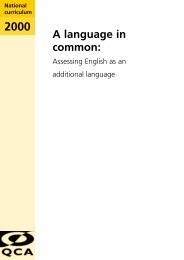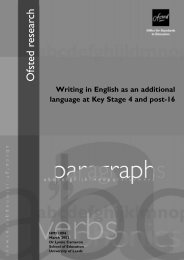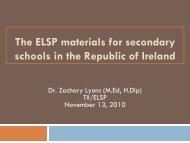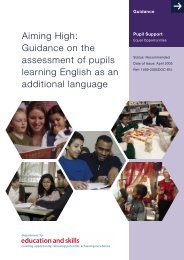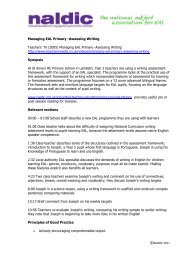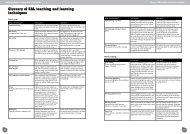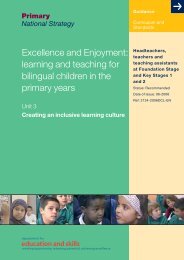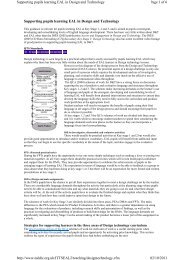Excellence and Enjoyment: learning and teaching for ... - NALDIC
Excellence and Enjoyment: learning and teaching for ... - NALDIC
Excellence and Enjoyment: learning and teaching for ... - NALDIC
You also want an ePaper? Increase the reach of your titles
YUMPU automatically turns print PDFs into web optimized ePapers that Google loves.
the initiative <strong>and</strong> all staff should be enabled to attend. The themes<strong>for</strong> the PDMs are drawn from the key str<strong>and</strong>s of the piloted EALprogramme <strong>and</strong> are designed to establish essential aspects of practicewhich should be in place.PDMs will require further development <strong>and</strong> tailoring at school levelto take account of schools’ varied starting points, individualcharacteristics <strong>and</strong> priorities identified in the RAPs.The delivery of PDMs may be supported by colleagues from theLocal Authority Advisory Service (Primary Strategy or EMA teams).The actual number <strong>and</strong> range of PDMs which are delivered may alsovary depending on schools' priorities identified in the RAPs. However,schools are recommended to identify at least three PDMs each term intheir RAP. Additional professional development meetings will provideopportunities <strong>for</strong> drawing together <strong>and</strong> consolidating <strong>learning</strong>outcomes from related work undertaken across the school.The decisions that have been made about the order in which thePDMs will be developed are intended to ensure that there is early <strong>and</strong>significant impact on <strong>learning</strong> <strong>and</strong> <strong>teaching</strong> in the classroom.Details of the content of each PDM can be found on the fliersincluded in these materials. A suggested programme to support CPDis outlined below:section 3Learning <strong>and</strong> <strong>teaching</strong>: assessment <strong>for</strong> <strong>learning</strong>PDM 1Establishing layered curriculum targets as acontext <strong>for</strong> language developmentPDM 6Day-to-day assessmentLearning <strong>and</strong> <strong>teaching</strong>: language development <strong>and</strong> curriculum accessPDM 2PDM 3PDM 4PDM 5EAL principles,Integrated planningSupportiveSpeaking <strong>and</strong>pedagogy <strong>and</strong><strong>for</strong> languagecontexts: scaffoldinglistening: guidedpractice: first languagedevelopment <strong>and</strong>language <strong>and</strong> <strong>learning</strong>sessions <strong>for</strong> languageas a tool <strong>for</strong> <strong>learning</strong>curriculum contentdevelopmentConditions <strong>for</strong> <strong>learning</strong>PDM 7Culture <strong>and</strong> identity: ethos, environment <strong>and</strong> curriculumPartnerships beyond the classroomPDM 8Developing <strong>learning</strong> partnerships with parents, carers, families <strong>and</strong> communitiesPrimary National Strategy | 0013-2006DCL-EN | © Crown copyright 2006<strong>Excellence</strong> <strong>and</strong> <strong>Enjoyment</strong>: <strong>learning</strong> <strong>and</strong> <strong>teaching</strong> <strong>for</strong> bilingual children in the primary yearsIntroductory guide 27




